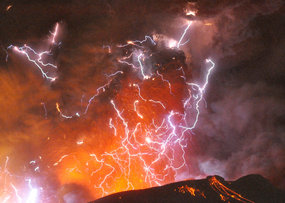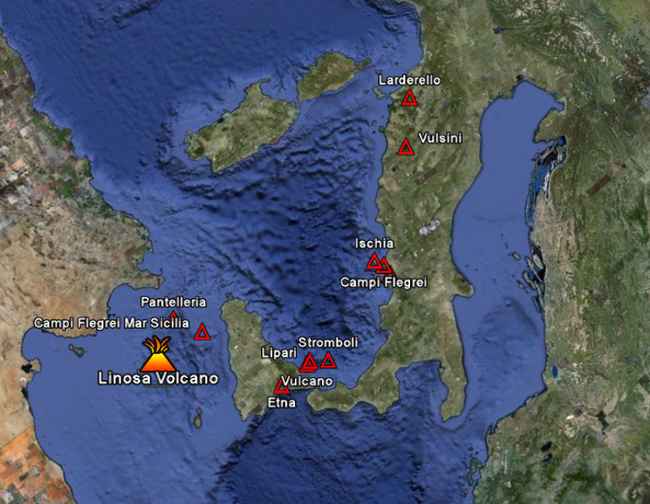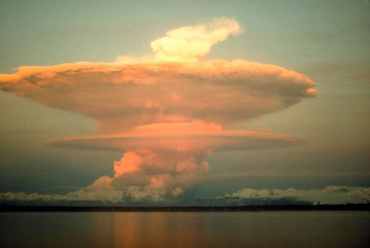Folks , the Electric Universe framework has convincing explanations for the entire gamut of anomalous phenomena associated with Earthquakes and Volcanoes - Thunder & lightning accompanying Earthquakes/Volcanoes , ball lightning , strange lights associated with Earthquakes etc. , unusual booming sounds and even bolts from the blue (in a cloudless sky) :
https://www.thunderbolts.info/wp/2015/11/27/earthquakes-and-volcanoes/
Earthquakes and Volcanoes
Stephen Smith November 27, 2015 picture of the day
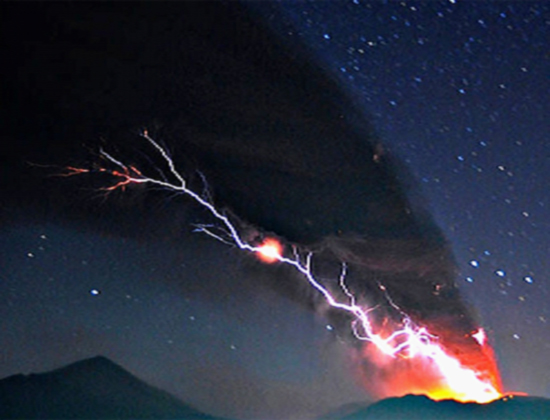
Lightning erupts from the crater of Mount Shinmoedake on the island of Kyushu in Japan. © Reuters News Agency
Nov 27, 2015
Lightning discharges in the atmosphere are familiar, but what about the ones underground?
The electrical phenomenon we call lightning is not well understood. The most common interpretation involves the circulation of water vapor up and down through clouds in a process called convection. Water is heated by the Sun until it evaporates, rising into the air where it collects into clouds. The water vapor continues to rise higher and higher, finally cooling enough to condense back into liquid. Earth’s gravity then pulls it back to the surface where the cycle repeats.
According to consensus opinions, water droplets tend to collide during convection, knocking electrons off one another, creating a charge separation. Electrons accumulate in the lower portion of the cloud, where it acquires a negative charge. As the droplets that have lost an electron continue to rise, they carry a positive charge into the top of the cloud.
The regions of charge differential, or charge separation, cause an electric field to form between them, with a strength directly proportional to the amount of charge in the cloud. The electric field can become so powerful that it repels electrons in the Earth’s surface, forcing it to become positively charged. A conductive pathway between the two regions can initiate a lighting leader stroke that eventually connects with some positive streamer rising from the ground.
Such a process cannot explain volcanic lightning. Most planetary scientists assume that the cause is similar, but there is no experimental evidence to confirm the idea.
Over the last two hundred years of reporting, lightning has been seen in the ash clouds spewing from numerous volcanic eruptions. Gigantic branching displays were photographed during the Mt. Chaiten eruption in May of 2008. There were reports of ball lightning bigger than beach balls rolling along the ground when Mt. St. Helens erupted in 1981. Eyjafjallajökull produced flashes that lit up the sky for many kilometers.
Large “telluric currents” have been found circulating through Earth’s crust because our magnetic field induces current flow in conductive strata. Thousands of amperes flow beneath the surface, varying according to conductivity. Since the Sun can affect Earth’s magnetic field through geomagnetic storms, fluctuations in telluric currents can occur when there is an increase in sunspots or solar flares, because they create oscillations in the ionosphere.
Sometimes earthquakes can produce flashes of light and other luminous events, as well. Ball lightning has been reported accompanying earthquakes, as have bright, colorful cloud-like formations floating in the sky above the fractured strata. It is not surprising that glow discharges occur before and after earthquakes: compressing quartz creates a flow of electric current. That is one reason why radio noise can be detected coming from areas under extreme stress. Is that stress only due to compression?
Quartz reacts to stress by producing electricity, but when electric charge flows through quartz it vibrates with a frequency coincident with the watts of power supplied to it. In a previous Picture of the Day, our planet was compared to a capacitor, capable of being charged and discharged by external electric fields.
A capacitor stores electric charge. Capacitors are constructed of two conductors, or “plates,” separated by a dielectric insulator. Electric charge on one plate attracts an opposite charge to the other, resulting in an electric field between them. As the capacitor’s charge increases, its electric field increases, stressing the insulator’s ability to separate opposite charges. If a high enough potential grows between the two conductive plates, the dielectric insulator will fail and the capacitor will short circuit, suddenly releasing the stored energy.
It is that phenomenon that most likely contributes to atmospheric lightning discharges. Stored electrical energy in the clouds and in the ground overcome the atmosphere’s ability to keep the two charges separate, so they reach out to each other as “leader strokes.” When the two lightning leaders meet, a circuit between the clouds and the ground (or between one cloud and another) is completed and a burst of electric current flashes along the conductive pathway.
Since magma can be considered a form of liquid plasma, it can also conduct electricity. As the ionosphere is charged up by solar flares, opposite charge is attracted to subterranean magma. Electric currents in plasma pinch down into filaments and form double layers. Electromagnetic forces between current filaments and between double layers can cause sudden pressure variations.
If, as stated above, the charge differential between layers becomes too great, a double layer can explode, releasing all of its energy flow instantaneously. So, earthquakes can be considered a form of underground lightning. If there is a break in the strata, permitting magma to reach the surface, the arc discharge might connect to the outside and a lightning bolt will leap from the cone of a volcano.
If earthquakes are underground lightning bolts, then perhaps seismic waves are the thunderclaps. In that case, it seems likely that the majority of energy release during an earthquake is not from the fracturing and movement of rock strata, but is the result of electrical energy detonating within the matrix.
Stephen Smith
Thunderbolts of the Gods , by David Talbott and Wallace Thornhill, introduces the reader to an age of planetary instability and earthshaking electrical events in ancient times. If their hypothesis is correct, it could not fail to alter many paths of scientific investigation.
More info
The Electric Sky . Professor of electrical engineering Donald Scott systematically unravels the myths of “Big Bang” cosmology, and he does so without resorting to black holes, dark matter, dark energy, neutron stars, magnetic “reconnection,” or any other fictions needed to prop up a failed theory.
More info
The Electric Universe . In language designed for scientists and non-scientists alike, authors Wallace Thornhill and David Talbott show that even the greatest surprises of the space age are predictable patterns in an electric universe.
More info
electric discharge, electric fields, Eyjafjallajökull, Lightning, Mt. Chaiten, volcano. Bookmark.
https://www.holoscience.com/wp/electric-earthquakes/
Electric Earthquakes
December 21st, 2005 Wal Thornhill EU Views
Civilization’s interest in predicting the location and time of damaging earthquakes is clear. The potential for devastation of property that otherwise could be secured, and the loss of life that otherwise could be prevented, are powerful reasons to find predictive factors.
Picture Credit: history.library.ucsf.edu/imagelib/ Chart: New Scientist
Some scientists have become aware of a correlation between sunspots and Earthquakes and want to use the sunspot data to help predict earthquakes. The theory is that an intensification of the magnetic field can cause changes in the geosphere. The NASA and the European Geosciences Union have already put their stamp of approval on the sunspot hypothesis, which suggests that certain changes in the sun-earth environment affects the magnetic field of the earth that can trigger earthquakes in areas prone to it. It is not clear how such a trigger might work.
In the Journal of Scientific Exploration, Vol. 17, No. 1, pp. 37–71, 2003, there is an excellent report that addresses the more down-to-earth problems facing geophysicists trying to understand earthquakes. The paper is titled, Rocks That Crackle and Sparkle and Glow: Strange Pre-Earthquake Phenomena, by Dr. Friedemann T. Freund, a professor in the Department of Physics, San Jose State University, and a senior researcher at NASA Ames Research Center. Dr. Freund writes:
“Many strange phenomena precede large earthquakes. Some of them have been reported for centuries, even millennia. The list is long and diverse: bulging of the Earth’s surface, changing well water levels, ground-hugging fog, low frequency electromagnetic emission, earthquake lights from ridges and mountain tops, magnetic field anomalies up to 0.5% of the Earth’s dipole field, temperature anomalies by several degrees over wide areas as seen in satellite images, changes in the plasma density of the ionosphere, and strange animal behavior. Because it seems nearly impossible to imagine that such diverse phenomena could have a common physical cause, there is great confusion and even greater controversy.”
Freund outlines the basic problem:
“Based on the reported laboratory results of electrical measurements, no mechanism seemed to exist that could account for the generation of those large currents in the Earth’s crust, which are needed to explain the strong EM signals and magnetic anomalies that have been documented before some earthquakes. Unfortunately, when a set of observations cannot be explained within the framework of existing knowledge, the tendency is not to believe the observation. Therefore, a general malaise has taken root in the geophysical community when it comes to the many reported non-seismic and non-geodesic pre-earthquake phenomena. There seems to be no bona fide physical process by which electric currents of sufficient magnitude could be generated in crustal rocks.”
Freund makes an excellent attempt to explain all of the phenomena in terms of rock acting like a p-type semi-conducting material when placed under stress. Normally rock is a good insulator. For example, the emission of positive ions from the Earth’s surface may act as nuclei for the ground-hugging fog that sometimes occur prior to earthquake activity. And although the surface potential may only be in the 1–2-Volt range, the associated electric field across a thin surface layer can reach hundreds of thousands of volts per centimeter, enough to cause corona discharges, or “earthquake lights.” Thermal anomalies seen from space before an earthquake may be due to the emission of infra-red light where the semi-conductor charge recombines at the surface. Disturbed animal behavior may be due to the presence of positive ions in the air.
As Freund says, this theory places an explanation in the realm of semiconductor physics, which means that geoscientists are not the best people to judge it. That explains why the paper appears in a speculative journal. Freund laments, “the peer review system often creates near-insurmountable hurdles against the publication of data that seem contrary to long-held beliefs.” Freund has identified a source of charge in stressed rocks that was not believed possible. He says, “once fully told and understood, the ‘story’ [of p-holes] is basically so simple that many mainstream geoscientists are left to wonder why it has taken so long for them to be discovered. If they are so ubiquitous as they appear to be, why did p-holes go unnoticed for over a hundred years?” Confronted with this question, by a twist of logic, many ‘mainstreamers’ succumb to the impulse to reject the p-hole concept out of hand. Other geologists find it hard to believe that positive holes liberated so deep down could flow to the Earth’s surface and collect there without being reabsorbed. However, earthquake lights are a real phenomenon, and some kind of mechanism must be creating them. Whatever it is, says Chris Marone, who works on the physics of rock deformation at Pennsylvania State University in University Park, it will involve maintaining charge over surprisingly large distances. “This is a very, very hard problem.”
The difficulties encountered in connection with p-holes are similar to others that have punctuated the history of science. The discovery of the p-holes as dormant yet powerful charge carriers in the Earth’s crust calls for a new paradigm in earthquake research and beyond. More often than not, any call for a new paradigm elicits opposition. Freund closes with a quote from the philosopher Arthur Schopenhauer:
“all truth passes through three stages. First, it is ridiculed. Second, it is violently opposed. Third, it is accepted as being self-evident.”
If Freund has a problem getting such a simple idea accepted, how much more difficult is it going to be to get both astronomers and geoscientists to accept that the Earth is a charged body in an ELECTRIC UNIVERSE®?
The missing link between the sunspots and earthquakes is the fact that the electric discharges to the Sun that cause sunspots can also affect the Earth’s ionosphere. The ionosphere forms one “plate” of a capacitor, while the Earth forms the other. Changes of voltage on one plate will induce movement of charge on the other. But unlike a capacitor, the Earth also has charge distributed in rock beneath the surface. And if the subsurface rock has become semi-conducting because of stress, there is an opportunity for sudden electrical breakdown to occur through that rock. We should expect similar processes to occur underground as is found in atmospheric lightning. There will be precursor electromagnetic effects due to the small-scale travelling of charge – rather like “stepped leaders” between cloud and ground. That may be the limit of activity in small tremors. But in a large earthquake, the entire circuit may be involved, from below the Earth, through the atmosphere to the ionosphere. This would explain the massive disturbance of the ionosphere over a large area accompanying a major earthquake.
The mystery of the source of the current is solved – it comes from a charged Earth. And the link with sunspots via the ionosphere is exposed. Subterranean lightning causes earthquakes! Seismic waves are the rumble of underground thunder. The energy released may be equivalent to the detonation of many atomic bombs but only a small proportion need come from the release of strain in the rocks. Most of it comes from the Earth’s stored internal electrical energy.
The latest issue of the IEEE journal, SPECTRUM, features an article based on Freund’s work that looks at ways of predicting earthquakes. Once again, it seems that scientific advances fare better today in the hands of electrical engineers.
See www.spectrum.ieee.org/dec05/2367.
There is a corollary to this story, which concerns the mysterious fragmentation of comets. The observation of more than 20 cases of comet fragmentation led to the thought that comet nuclei are poorly cohesive rubble piles. But comet nuclei that have been imaged closely show that they are cohesive, rocky bodies with sharp relief (notwithstanding theoretical speculations about their origin from dust and erroneous densities derived from gravitational theory). Comet Tempel 1 was no exception yet surprising quantities of extremely fine dust were seen in the Deep Impact experiment. The dust came from electrical sputtering of the rocky comet surface. An impact will dislodge much larger particles.
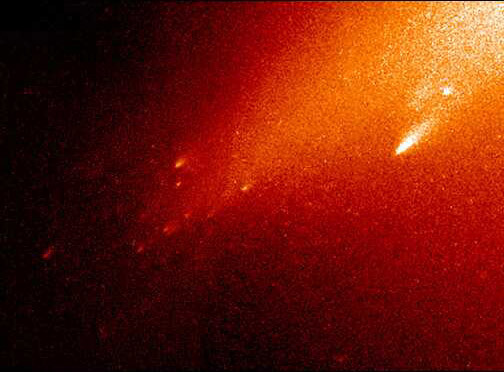
The Hubble picture shows that the comet Linear nucleus has been reduced to a shower of glowing "mini-comets" resembling the fiery fragments from an exploding aerial firework. Credit: NASA, Harold Weaver (the Johns Hopkins University), and the HST Comet LINEAR Investigation Team.
So, being rocky bodies like the Earth and in the same electrical environment of the solar system, comets will carry significant electrical charge distributed throughout the nucleus. However, unlike the Earth, conducting plasma is in contact with the comet nucleus so that electrical discharges reach right down to the surface where they are concentrated in cathode jets, seen emanating from the nucleus.
The rocks in the comet nucleus are not under mechanical stress so they are good insulators. However, the increasing loss of charge from the surface of the comet nucleus, as it rushes toward the Sun, develops electrical strain within the nucleus. If a subsurface discharge results, the comet suffers a “cometquake,” which may disrupt the nucleus. The small velocities imparted to rocks by the quake are sufficient for them to escape the gravity of the nucleus.
Wal Thornhill

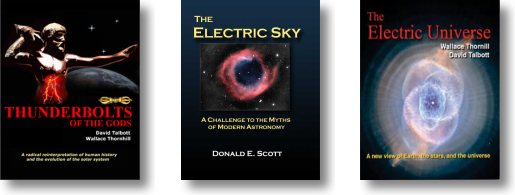

 [
[